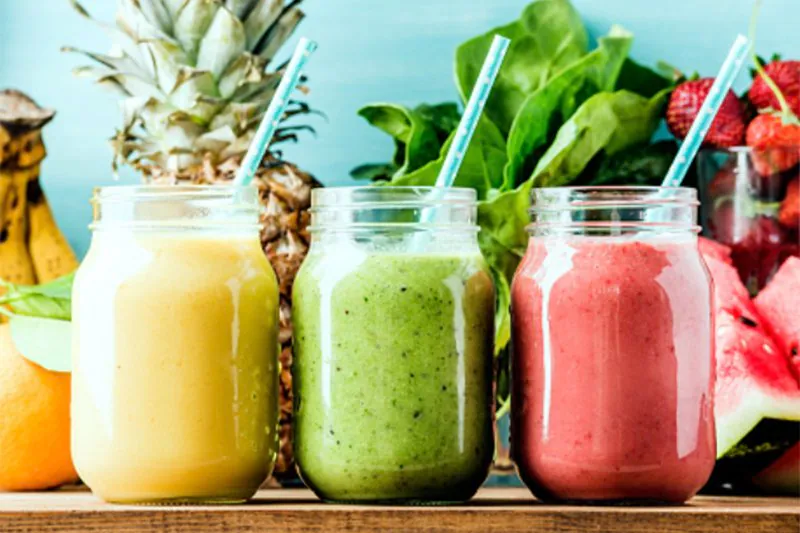How to Make a Nutritious Smoothie

Smoothies are a popular choice for a reason: blending wholesome ingredients together not only delivers great nutrition but also offers a delicious and convenient option for those on the go.
Dietitian Jordan Spivak from Sibley Memorial Hospital highlights that making smoothies at home allows you to use ingredients that match your nutritional needs and taste preferences, providing a great source of protein, fiber, and other essential nutrients.
What to Include in a Smoothie?
One of the best features of smoothies is their versatility. With so many options available, Spivak recommends starting with these basic ingredients:
- Protein: Commercial protein powder, Greek yogurt (higher in protein than regular yogurt), or nut butters.
- Fruit: Berries, mango, bananas, and avocado.
- Greens: Spinach or kale.
- Liquid Base: Dairy or plant-based milk, water, or fruit juice.
Any type of blender can be used, from large kitchen models to smaller, portable ones, making it easy for you to create smoothies anywhere.
Protein Powders: A Key Ingredient
Many protein smoothie recipes include protein powder. Spivak emphasizes the importance of protein in smoothies, stating it helps build and maintain muscle mass while keeping you satisfied longer.
Choosing the right protein powder can be overwhelming with so many options available. Here are some tips for selecting the right one:
Check the Label
Since protein powder is processed, it’s essential to carefully read the label. You should check for allergens, the amount of protein and carbohydrates, and whether it contains added sugars or artificial flavors.
Whey Protein Powder
Whey protein is Spivak’s top recommendation, as it’s easily absorbed by the body. Whey, a byproduct of cheese production, is rich in leucine, an amino acid that plays a crucial role in muscle energy and growth, tissue repair, and metabolism.
Possible Side Effects of Whey Protein
While generally safe, whey protein may cause issues like:
- Stomach discomfort
- Frequent bowel movements
- Acne
- Increased thirst and fatigue
- Bloating
- Headaches
If you experience any of these symptoms, stop using whey and consult a healthcare provider.
Plant-Based Protein Powders
For those following a vegan diet, plant-based options like pea protein are excellent choices. While plant proteins are not always as easily absorbed as animal-based ones, pea protein is one of the best plant sources.
Other Protein-Rich Additions
Aside from protein powders, you can boost your smoothie’s protein content with:
Yogurt
Greek yogurt is an excellent source of protein and probiotics. Opt for those lower in added sugars for a healthier smoothie. Vegan yogurt alternatives, such as almond or coconut-based options, also work well.
Nut Butters
Nut butters, like peanut butter, add protein, healthy fats, and flavor to your smoothie, helping to keep you full longer.
Seeds
If you’re allergic to peanuts, sunflower seed butter or ground flaxseeds are good alternatives, providing protein and healthy omega-3 fatty acids.
How Much Protein Should You Add?
The amount of protein needed varies from person to person. Spivak recommends following the serving guidelines on protein powder labels, typically 1-2 scoops. Additionally, consider other protein-rich ingredients like yogurt, nut butter, and seeds.
If you’re unsure how much protein suits your needs, consulting a dietitian can help you tailor your smoothie to your health goals.
Healthy Fruit Choices for Smoothies
Whole fruits are better for smoothies than fruit juices, as they retain fiber and are less likely to spike blood sugar. Fruits are packed with antioxidants, which support cellular health and reduce inflammation.
Spivak recommends trying:
- Raspberries, blueberries, and strawberries – rich in fiber and vitamins.
- Bananas – high in potassium and fiber, promoting fullness.
- Mangos – a delicious source of fiber and vitamin A.
- Avocado – creamy and rich in fiber, making smoothies smooth and filling.
Keep in mind that fruit contains carbohydrates, which can affect blood sugar, so it’s best to consult a dietitian for personalized recommendations.
Vegetables to Add to Your Smoothie
Incorporating vegetables into smoothies is a great way to ensure you’re meeting your daily veggie intake. Here are some excellent vegetable options:
- Carrots – naturally sweet and full of vitamin A.
- Cucumber – refreshing and hydrating, perfect for summer smoothies.
- Beets – packed with minerals and a natural sweetness.
- Cauliflower – adds fiber and nutrients without altering the taste.
- Cooked sweet potatoes – creamy and full of vitamins.
Sample Smoothie Recipes
Nut Butter and Banana Smoothie
Blend together:
- 2 tbsp of peanut, almond, or sunflower butter
- 1 frozen or fresh banana
- 1 scoop of vanilla or chocolate protein powder
- ½ cup of vanilla Greek yogurt (or coconut yogurt as a vegan alternative)
- 1 cup of liquid base (water or plant-based milk)
- 1 tbsp of ground flaxseed
- A few ice cubes
Nutrition per serving: 482 calories, 37.4g protein, 22.3g fat, 41g carbs.
Berry Green Smoothie
Blend together:
- 1 cup of frozen mixed berries
- A handful of spinach (fresh or frozen)
- 1 scoop of vanilla protein powder
- ½ cup of vanilla Greek yogurt (or coconut yogurt)
- 1 cup of base liquid (water or milk)
- 1 tbsp of ground flaxseed
- A few ice cubes
Nutrition per serving: 303 calories, 30.4g protein, 6.8g fat, 35.8g carbs.
Not Just for Breakfast
Although smoothies are commonly associated with breakfast, they can be an excellent meal replacement or snack. Spivak suggests preparing smoothies in bulk and storing them for quick, nutritious meals when needed. Frozen fruits and veggies can maintain their nutritional value for extended periods, making them a convenient option for busy days.













